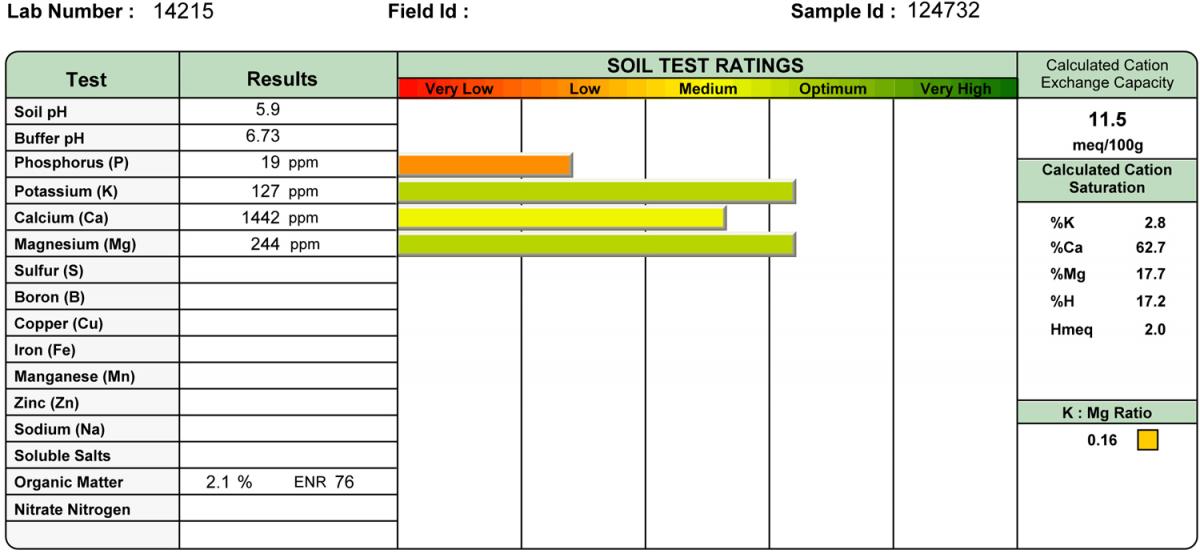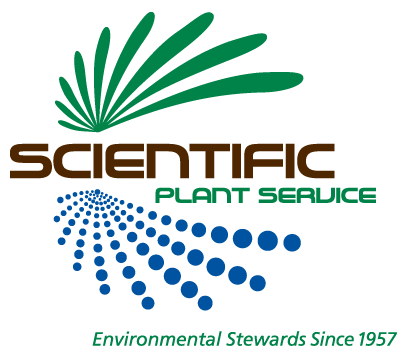Your Soil Test
Understanding Your Soil Test
A year ago, I wrote about soil testing and the State of Maryland’s requirement that all clients have their soil tested at start up of service and every three years thereafter (see below) and is reiterated in the Maryland Nutrient Management Law approved during the 2011 legislative session to reduce nutrient runoff in the Chesapeake Bay.
Our laboratory analysis is a basic soil test that provides: soil pH, buffer pH, phosphorus (P), potassium (K), calcium (Ca), magnesium (Mg), cation exchange capacity (CEC), calculated cation saturation, organic matter, and K:Mg ratio, exceeding the minimal Maryland Law requirements for P, K and pH levels. Optional testing can be done for: boron (B), sulfur (S), copper (Cu), iron (Fe), manganese (Mn), zinc (Zn), sodium (Na), (trace minerals), and soluble salts. These tests would be done for persistent color or health issues with turf or ornamental shrub issues.
The laboratory submits recommendations based on their test results and University of Md standards. These include how much lime per each 1000 sf to raise the pH level and nutrient requirements of Nitrogen (N), Phosphorus (P) and Potassium (K). Occasionally, the Lab will recommend adding Calcium or Magnesium, when levels are low. pH between 6.0-7.0 is the best range for growing grass. Phosphorus levels between 40-100 and potassium levels between 120-200require no further attention.
Cation exchange capacity (CEC) indicates the capacity of the soil to hold onto positively charged ions-Ca, Mg, K, Na, Hydrogen(H),Aluminum (Al), Fe, Mn, Zn, and Cu. It is a measurement of fertility and nutrient retention capacity. Therefore, a higher CEC means the soil is better able to hold and exchange elemental ions. Generally clay and organic soils have a higher CEC than sandy soils which yield low CEC readings. Therefore, someone living in Anne Arundel County generally would have a lower CEC than a property in say, Howard County. I have read where a measurement of between 10 and 30 is ideal for agricultural soil; Loamy Soil CEC of 4-8 is normal and Clay would be higher.
Organic Matter balances soil pH and improves soil texture and is also a source of trace elements. Organic Matter is plant and animal residues in various stages of decay. Regarding Organic Matter, a high number reading is good, but 3-5% is sufficient.
Let’s look at some Soil Test results:
| Sample test #1: | Sample test #2: |
| pH: 6.8 | pH: 5.3 |
| Buffer pH: 6.88 | Buffer pH: 6.49 |
| P: 15 | P: 37 |
| K: 144 | K: 83 |
| Ca: 2100 | Ca: 1585 |
| Mg: 497 | Mg: 186 |
| CEC: 15.5 | CEC: 14 |
| Organic Matter: 3% | Organic Matter: 3.4% |
| Sample test #3: | Sample test #4: |
| pH: 5.6 | pH: 7.4 |
| Buffer pH: 6.76 | Buffer pH: not tested (not needed) |
| P: 38 | P: 15 |
| K: 116 | K: 123 |
| Ca: 831 | Ca: 3323 |
| Mg: 156 | Mg: 168 |
| CEC: 7.5 | CEC: 18.3 |
| Organic Matter: 1.9% | Organic Matter: 2.5% |
Sample #1 shows adequate pH, low level of P, Medium levels of K and Ca ;Very High Mg, Good CEC, Adequate Organic Matter
This sample indicates the need for extra Phosphorus.
Sample #2 Low pH, Low level of P and K, Medium levels of Ca and Mg; Good CEC
Adequate Organic Matter
This sample indicates the need for Lime as well as extra Phosphorus and Potassium.
Sample #3 Low pH, Low levels of P and K; Medium Ca; High Mg; Low CEC
Low Organic Matter
This sample indicates the need for Lime as well as extra Phosphorus and Potassium.
Sample #4 Slightly high pH. Low P and K,Very High Ca, Low Mg Good CEC
Low Organic Matter
This sample indicates the need for extra Phosphorus.
All four test results are from the 2011 batch of samples taken from SPS clients. All are quite distinct. It is not uncommon to see some sort of deficiency in our client’s samples when starting a program. It is not uncommon to see lower pH readings over a period of time as many factors contribute to soil acidity. The key to a healthy lawn is to have a pH between 6.0 and 7.0 and adequate levels of P and K to get the best results from
Scientific Plant Service Maintenance Fertilization.
Questions ? Please speak with your Representative.
Winter 2011
Damian Varga
n the late 1990’s, the Maryland Nutrient Management Law was enacted to reduce fertilizer runoff that reached the Chesapeake Bay. This law directly impacts companies that provide lawn care services. By law, soil testing is required at initial service and every three years thereafter while the property is under the care of a professional company. A standard soil test confirms the pH of the soil (% acidity) as well as levels of Phosphorus (P), Potassium (K), Calcium (Ca) and Magnesium (Mg). Once this information is obtained, recommendations are made regarding additional nutrients, P, K, Mg or pH correction with lime on your lawn.
Should your soil test indicate low P or K, remedial applications of a high P or K fertilizer is recommended. If the pH is below 6.2, we will suggest lime applications. A high pH is rare, however, can be addressed using sulphur. Ca and Mg deficiencies are rare as well, but pelletized gypsum can be applied to remedy these deficiencies. It is crucial to maintain an acceptable pH level to get proper effect and release from all applied nutrients.
Proper Nitrogen (N) levels are critical to maintain quality turf, i.e. turf that is resistant to pest problems (insects and disease), are better able to tolerate stress and recover from damage (environmental stress, pests, and foot traffic). P, on the other hand, is crucial in seed establishment. With mature grass, a deficiency in P reduces the turf’s ability to tolerate drought, causes reduced vigor and density, as well as, can cause poor spring green-up. K is important to lessen damage from summer and/or winter stresses. Its role with mature turf involves tolerance to heat, cold and drought. K deficiencies manifests itself as thin, off-color and non-vigorous turf. Whereas N is used readily during the growing season, P and K are very stable elements and are seldom depleted. Along these lines of thinking (and in accordance with the Bay Initiative), K and P are seldom used during the growing season. Some retail vendors still market “Winterizer” fertilizer that is high in P and K. When soil tests reveal adequate P & K, why automatically add more to the environment!

With focus on the Chesapeake Bay’s health, SPS made the commitment several years ago to use “Bay-Friendly” POLYON fertilizer. Since this product releases its nutrients based on temperature, N is not wasted, therefore, unlike competitor’s programs, SPS applies 30% less nitrogen to our client’s lawns with excellent results. With the city of Annapolis banning all fertilizers containing K several years ago, we decided this was a trend that would eventually become law throughout Maryland. SPS anticipated up-coming change and eliminated unneeded P from it’s custom fertilizer blends.
Basic “maintenance” fertilizer is the foundation of our lawn care program. This means the standard yearly program will meet the nutritional needs of turfgrass based on University Research. In order for nutrients to be fully utilized by turf, the pH needs to be in the 6.0-7.0 range, and the P and K need to be in sufficient quantities in the soil. Without these elements being in balance, the results from the yearly program may be less than satisfactory.
Scientific Plant Service, Inc., encourages you to have soil tested performed at the appropriate intervals.
Remember TESTING ……. IT’S THE LAW!

